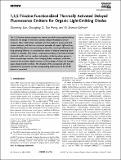1,3,5-Triazine-functionalized thermally activated delayed fluorescence emitters for organic light-emitting diodes
Abstract
The 1,3,5-triazine electron acceptor has become one of the most popular building blocks for the design of thermally activated delayed fluorescence (TADF) materials. Many TADF design strategies are first applied in compounds that contain triazines, and there are numerous examples of organic light-emitting diodes (OLEDs) with triazine-containing emitters that show high efficiencies and long operating lifetimes. A comprehensive review of triazine-containing TADF emitters is provided. This review is organized according to the triazine-derived structural motifs, such as number and position of electron-donor groups in donor?acceptor-type emitters, the π-bridging linkers employed, orientation control of the transition dipole moment, and the design of chiral and through-space charge-transfer emitters. The structure of the compounds with their optoelectronic properties and the corresponding performance of the OLED devices is correlated.
Citation
Sun , D , Si , C , Wang , T & Zysman-Colman , E 2022 , ' 1,3,5-Triazine-functionalized thermally activated delayed fluorescence emitters for organic light-emitting diodes ' , Advanced Photonics Research , vol. 3 , no. 11 , 2200203 . https://doi.org/10.1002/adpr.202200203
Publication
Advanced Photonics Research
Status
Peer reviewed
ISSN
2699-9293Type
Journal item
Description
D.S acknowledges support from the Royal Academy of Engineering Enterprise Fellowship (EF2122-13106). This project has received funding from the European Union's Horizon 2020 research and innovation program under the Marie Skłødowska-Curie grant agreements No. 897098 (AIE-RTP-PLED). T.W. acknowledges support from the Marie Skłodowska-Curie Individual Fellowship. C.S. acknowledges support from the China Scholarship Council (201806890001). The authors thank the EPSRC (EP/P010482/1) for financial support.Collections
Items in the St Andrews Research Repository are protected by copyright, with all rights reserved, unless otherwise indicated.

